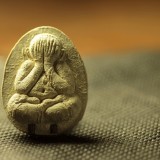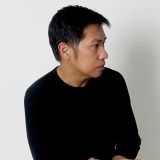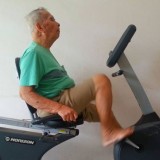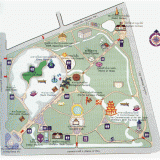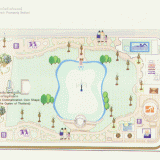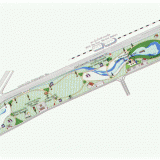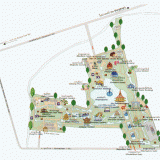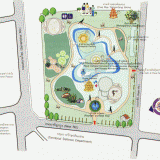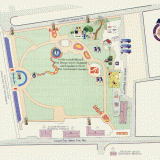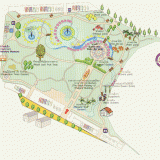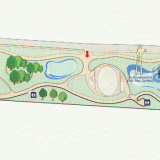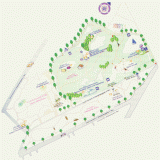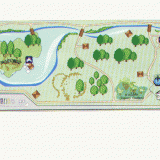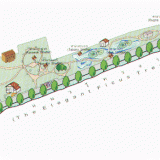
คำกล่าวที่ว่า “ชีวิตเริ่มต้นเมื่ออายุสี่สิบ” นั้นเป็นคำคมแห่งศตวรรษที่ 20 ซึ่งอาจมีน้อยคนที่จะรู้ว่า คำพูดที่น่าจะถูกต้องตามข้อเท็จจริงทางประวัติศาสตร์ช่วงก่อนหน้านั้น อาจเป็น “ความตายเริ่มขึ้นตอนอายุสี่สิบ” เพราะคนส่วนใหญ่ไม่ได้มีชีวิตอยู่นานนักหลังจากนั้น อายุขัยเฉลี่ยของชาวอังกฤษในยุคกลางนั้นอยู่ที่ 25 ปี และเพิ่งถึง 40 เมื่อราวๆสองร้อยปีก่อนนี้เอง
ในปี 1930 คนจำนวนมาก (อย่างน้อยก็ในสังคมตะวันตก) สามารถมีชีวิตหลังเกษียนที่สะดวกสบายพอใช้ เป็นอิสระจากงานและการเลี้ยงลูก อุปกรณ์อำนวยความสะดวกเช่นเครื่องซักผ้าและเครื่องดูดฝุ่นกำลังเป็นที่นิยมมากขึ้นเรื่อยๆซึ่งช่วยเบางานของแม่บ้านทั้งหลาย ทำให้สาวๆมีเวลาพักผ่อนมากกว่าแม่ของพวกหล่อนจากยุควิคตอเรียน
ปี 1932 วอลเตอร์ พิทคิน นักจิตวิทยาชาวอเมริกันได้ตีพิมพ์หนังสือเชิงพัฒนาตนเองในชื่อ “ชีวิตเริ่มต้นตอนสี่สิบ” และได้กล่าวไว้ว่า
“ชีวิตเริ่มต้นเมื่ออายุสี่สิบ สิ่งนี้เป็นผลของการปฏิวัติแห่งยุคใหม่ วันนี้มันเป็นเพียงความจริงแค่ครึ่งเดียว แต่ในวันรุ่งขึ้นมันจะเป็นสัจธรรม”
พิทคินได้รับเครดิตในฐานะผู้บัญญัติคำกล่าวนี้ แต่แม้ว่าหนังสืออันโด่งดังของเขาจะทำให้มันเป็นที่ใช้กันอย่างแพร่หลาย เขาก็ไม่ใช่คนแรกที่มีแนวคิดดังกล่าว หรือใช้ประโยคก่อนด้วยซ้ำ มันปรากฏบนหน้าหนังสือพิมพ์และสื่อสิ่งพิมพ์หลายครั้งตั้งแต่ปี 1932 เป็นต้นมา แนวคิดที่ว่านี้ยังถูกผลักดันเข้าไปในจิตสำนึกของชาวอเมริกันลึกขึ้นไปอีกเมื่อโซฟีทัคเกอร์ ปล่อยเพลง “Life begins at forty” ซึ่งเขียนโดย Yellenและ Shapiro ออกมาในปี 1937
อย่างไรก็ตาม เราต้องมองย้อนกลับไปพอสมควรเพื่อจะพบที่มาจริงๆของคำกล่าวนี้ อาร์เธอร์โชเพินเฮาเออร์ นักปรัชญาชาวเยอรมันผู้ยิ่งใหญ่แห่งศตวรรษที่ 19 ได้ให้ความเห็นซึ่งเฉียดใกล้กับแนวคิดนี้มากว่า
“สี่สิบปีแรกของชีวิตนั้นเป็นอรรถบท สามสิบปีหลังนั้นคืออรรถกถา”
จากการลดลงของภาระหน้าที่ในงานบ้านและการเลี้ยงดูเด็กอันหมายถึงเวลาว่างซึ่งมากขึ้นของผู้หญิงในช่วงเริ่มต้นของศตวรรษที่ 20 ทำให้เราทราบว่าแนวคิดที่ว่าชีวิตเริ่มต้นในวัยสี่สิบ (ซึ่งกำเนิดขึ้นไม่นานก่อนหน้านั้น) มีเป้าหมายถึงผู้หญิงโดยเฉพาะ
นางธีโอดอร์ พาร์สันส์ ผู้เป็น physical director ของโรงเรียนต่างๆในชิคาโก ได้เขียนหนังสือ brain culture through scientific body building ซึ่งได้ตีพิมพ์ในปี 1912 มันไม่ได้เป็นหนังสือที่ดังเปรี้ยงปร้างทันทีที่วางแผง แต่การมาถึงของสหรัฐฯในสงครามโลกครั้งที่ 1 ในปี 1917 ได้ทำให้มุมมองของเธอกลายเป็นประเด็นซึ่งเป็นที่สนใจ ในเดือนเมษายนของปีเดียวกันนั้น เดอะพิทส์เบิร์ก เพรส ได้ตีพิมพ์บทความเกี่ยวกับนางพาร์สันส์และความเห็นอันมีเหตุผลของเธอเกี่ยวกับประโยชน์ของโปรแกรมออกกำลังกายซึ่งเธอได้รับมาจากสามีอดีตทหารของเธอ (นายธีโอดอร์ได้เสียชีวิตไปไม่นานก่อนหน้านั้น)
“ผู้หญิงส่วนใหญ่ไม่รู้วิธีหายใจ นั่ง ยืน หรือเดินที่ถูกต้อง ในเวลานี้ฉันต้องการผู้หญิงฝึกฝนสำหรับหน้าที่พิเศษต่างๆ ที่จะตกอยู่ในความรับผิดชอบของพวกเราในช่วงหน้าศึก ความตายเริ่มขึ้นในวัยสามสิบ นั่นคือเวลาที่เซลล์กล้ามเนื้อเริ่มเสื่อมลง การให้ความสนใจกับอาหารและการออกกำลังกายจะทำให้ทั้งชายและหญิงในอนาคตมีอายุที่ยืนยาวกว่าในปัจจุบัน เพราะช่วงชีวิตที่ดีที่สุดของผู้หญิงเริ่มต้นที่วัยสี่สิบ”
หน้าที่พิเศษซึ่งนางพาร์สันส์กล่าวมาข้างต้นนั้นไม่ชัดเจน แต่บทความที่ว่านี้มีทั้งรูปของสองสามีภรรยา และขั้นตอนของพวกเขา เพื่อที่เราๆท่านๆจะได้ทดลองดูว่าจะเป็นผลจริงหรือไม่
อายุขัยเฉลี่ยของคนได้เพิ่มขึ้นเรื่อยๆจนตอนนี้วัยสี่สิบดูไม่ใช่วัยแก่เฒ่าอย่างไรเลย
ในปี 1991 นิวยอร์คไทมส์ ได้ตีพิมพ์ความเห็นที่ว่า :
“มาตรฐานอายุของมนุษย์ จากที่เคยดูเหมือนจะแข็งแกร่งดั่งหินผา กลับกลายเป็นดั่งทรายที่พัดปลิว “ชีวิตเริ่มต้นที่วัยสี่สิบน่ะหรือ? เหมือนหกสิบมากกว่า”
What’s the meaning of the phrase ‘Life begins at forty’?
The notion that ‘life begins at forty’ is a 20th century one; prior to that it was more accurate to say ‘death begins at forty’ as most people didn’t live much beyond that age. Life expectancy in medieval England was around 25 years and only reached forty sometime around the turn of the 20th century.
By the 1930s many, in western societies at least, could expect a decent spell of reasonably affluent retirement, free from work and the responsibilities of childcare. Household gadgets like washing machines and vacuum cleaners were becoming more widely used and had begun to relieve women’s drudgery and offer them increasing amounts of leisure time as compared to their Victorian mothers.
In 1932, the American psychologist Walter Pitkin published the self-help book Life Begins at Forty. Pitkin stated confidently:
Life begins at forty. This is the revolutionary outcome of our New Era. Today it is half a truth. Tomorrow it will be an axiom.
Pitkin is often credited with coining the phrase and, while it is true that his popular book was the cause of it becoming part of the language, he wasn’t the first to express the idea, or even the phrase itself. The take-up of the idea was rapid and ‘life begins at forty’ appears many times in newspapers and other printed records from 1932 onwards. This was propelled further into the American consciousness in 1937 via a recording of the song ‘Life begins at Forty’, written by Yellen and Shapiro and sung by Sophie Tucker.
However, we need to go back a way to find the origin of the phrase. The great 19th century German philosopher Arthur Schopenhauer came close to it with his view:
“The first forty years of life give us the text: the next thirty supply the commentary.”
In keeping with the reduction of the toil of domestic work and child rearing that began freeing up women’s free time to some extent at the start of the 20th century, the first reference to life beginning at forty refers specifically to women.
Mrs. Theodore Parsons was Physical Director of Schools in Chicago and, in 1912, wrote Brain Culture Through Scientific Body Building. It wasn’t a runaway best-seller, but the arrival of the USA in the First World War in 1917 gave her views a new lease of life. In April of that year The Pittsburgh Press printed a feature on Mrs. Parsons and her no-nonsense opinions about the benefits of a brisk exercise programme that she acquired from her soldier husband (Mr. Theodore Parsons was, sadly, recently deceased – presumably from exhaustion):
“The average woman does not know how to breathe, sit, stand or walk. Now I want women to train for the special duties which may devolve upon them in war time. Death begins at thirty, that is, deterioration of the muscle cells sets in. Attention to diet and exercise would enable men and women to live a great deal longer than they do today. The best part of a woman’s life begins at forty.”
Life begins at forty What special duties Mrs. Parsons had in mind, stationed as she was in Chicago, isn’t clear. The paper was good enough to include a graphic of the dynamic couple, demonstrating their method in action, so you can give it a try and see if it works.
Life expectancy has continued to move on and forty now seems no age at all. In 1991, the New York Times printed this opinion:
All our age benchmarks, which used to seem solid as rocks, have turned into shifting sands. ‘Life begins at 40? More like 60′.
Credit:
https://www.phrases.org.uk
แปลและเรียบเรียงภาษาไทยโดย: วีร์ ศรีวราธนบูลย์











